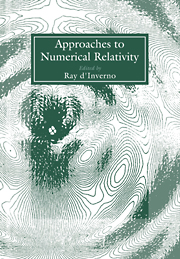Book contents
- Frontmatter
- Contents
- Contributors
- Introduction
- Preface
- PART A THEORETICAL APPROACHES
- Numerical relativity on a transputer array
- Some aspects of the characteristic initial value problem in numerical relativity
- The characteristic initial value problem in general relativity
- Algebraic approach to the characteristic initial value problem in general relativity
- On hyperboloidal hypersurfaces
- The initial value problem on null cones
- Introduction to dual-null dynamics
- On colliding plane wave space-times
- Boundary conditions for the momentum constraint
- On the choice of matter model in general relativity
- A mathematical approach to numerical relativity
- Making sense of the effects of rotation in general relativity
- Stability of charged boson stars and catastrophe theory
- PART B PRACTICAL APPROACHES
- PANEL DISCUSSION
The characteristic initial value problem in general relativity
Published online by Cambridge University Press: 15 December 2009
- Frontmatter
- Contents
- Contributors
- Introduction
- Preface
- PART A THEORETICAL APPROACHES
- Numerical relativity on a transputer array
- Some aspects of the characteristic initial value problem in numerical relativity
- The characteristic initial value problem in general relativity
- Algebraic approach to the characteristic initial value problem in general relativity
- On hyperboloidal hypersurfaces
- The initial value problem on null cones
- Introduction to dual-null dynamics
- On colliding plane wave space-times
- Boundary conditions for the momentum constraint
- On the choice of matter model in general relativity
- A mathematical approach to numerical relativity
- Making sense of the effects of rotation in general relativity
- Stability of charged boson stars and catastrophe theory
- PART B PRACTICAL APPROACHES
- PANEL DISCUSSION
Summary
Abstract. The difficulties in solving the characteristic initial value problem in general relativity when matter fields are included are discussed. A scheme is proposed with new dependent variables, coordinates and tetrad which should alleviate some of the problems.
THE CHARACTERISTIC INITIAL VALUE PROBLEM
Almost all calculations in numerical relativity are based on the Arnowitt-Deser-Misner (1962) formalism in which spacetime is foliated by spacelike hypersurfaces. The Einstein equations are decomposed into elliptic constraint equations which are intrinsic to the slices, and hyperbolic evolution equations which govern the evolution from slice to slice. In principle the constraint equations have only to be solved on the initial slice, but even this requires considerable effort and a large computer.
Stewart and collaborators, Friedrich and Stewart (1982), Corkill and Stewart (1983), developed an alternative approach based on a fundamentally different principle. In this spacetime was foliated by null hypersurfaces, and originally two families of null hypersurfaces were used. A helpful analogy is to consider the Schwarzschild solution described by double null coordinates. Examination of that solution will reveal that such coordinates have many theoretical advantages. One can explore the spacetime through the regular event horizon right up to the singularity at r = 0. Further one can proceed out along surfaces u = const, to future null infinity, the area inhabited by distant observers. Indeed one can bring infinity in to a finite point by the technique of conformal compactification, due originally to Penrose.
- Type
- Chapter
- Information
- Approaches to Numerical Relativity , pp. 34 - 40Publisher: Cambridge University PressPrint publication year: 1992

